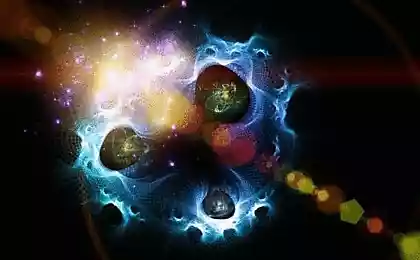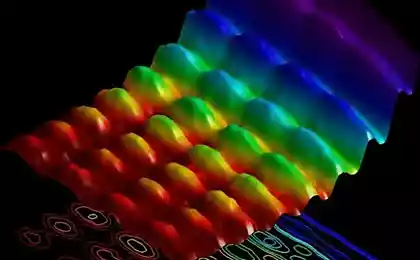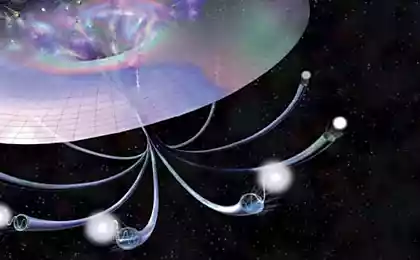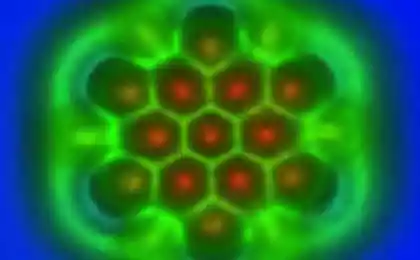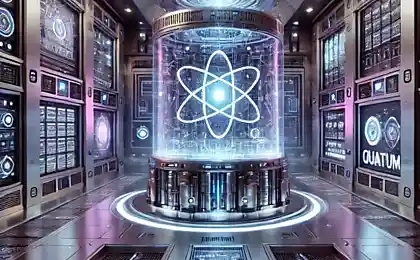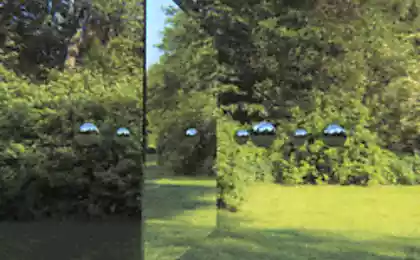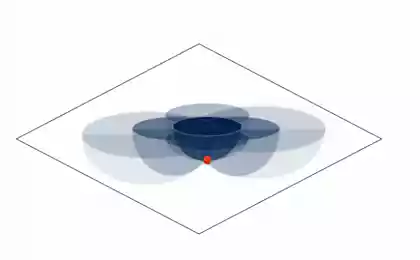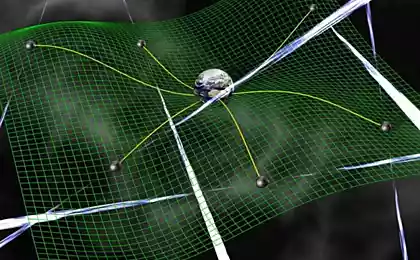738
About the strange quantum mechanics, qubits and concepts of computer
Physicist Seth Lloyd of the strange quantum mechanics, qubits and concepts of computer
A quantum computer is a device that stores and processes information at the level of individual atoms and elementary particles. In quantum computing there are two aspects: the first quantum and the second computational. "Quantum mechanics" — it sounds a little weird, and quantum mechanics is really unusual from a scientific point of view. But in a sense, the quantum aspect is easier to understand.
Quantum mechanics is a physical theory that explains how things behave on the small and fundamental level. It is the branch of physics that studies how atoms, photons (light particles), electrons, elementary particles behave. If we're going to build a computer at the level of atoms and the scale of elementary particles, it will inevitably work according to the laws of quantum mechanics. And we see that the strangeness of quantum mechanics the fact that quantum mechanics is weird and counterintuitive, in fact, allows us to calculate a way that was not for a laptop or iPhone.
The second aspect of quantum computing are the computing. So, what is a computer? Actually, it's kind of a difficult question, so I can say that computer is the computer where I see it when I type on it, or make phone calls or use Google maps. But in fact, the concept of the computer goes beyond the simple question of whether you have Apple or PC, iPhone or Samsung. This concept of information processing. What's a computer?
The digital computer receives the information and breaks it into smallest possible pieces called bits. Bit is an elementary distinction between two possibilities: Yes and no, true and false, zero and one or, for that matter, to low or high voltage charged capacitor in the computer. So the bits are physically stored within a conventional computer: low voltage capacitor is zero, the high unit.
To perform calculations the computer, having the information broken into tiny pieces, manipulates them, makes them interact and modifies them according to very General rules. In fact, there is the concept of a universal digital computing, covering the most complex tasks that can solve classical computer systematically in terms of bits. Thus, a quantum computer is a computer that takes bits and working with them in a systematic way, but it works at the level of atoms, elementary particles, photons (light particles), electrons — where reign the laws of quantum mechanics.
Quantum mechanics is weird. Strange is a scientific term. Niels Bohr, one of the founders of quantum mechanics said:
"Anyone who says he understands quantum mechanics, and he / she is not dizzy, really do not understand it."
Generally speaking, Danish is even more impressive. But it's true: quantum mechanics is weird and counterintuitive. To experience this oddity, think about what is called wave-particle duality. I know that sounds convoluted — corpuscular-wave dualism. What does that mean? This means that what we think of as particles, such as atoms or electrons, has a wave associated with it. Similarly, what we think of as waves, such as light or sound, has an associated particle. All this happens at a very microscopic level. This means that when you store a bit of information on a quantum computer, say, to the position of the electron, the electron also has an associated wave.
In a classical computer bit is stored in the following way: if zero is a low voltage — a bunch of electrons "here"; the unit is high voltage — a bunch of electrons "out there." Now let's zoom out to the point when we receive a quantum bit, i.e., one electron. So, one electron in one place, the unit is one electron in the other. Well, imagine the electron is zero, you move it back it becomes a unit, you move it here — he becomes again zero. You have two electrons, you move them around, you change a few bits — no problems with storing and processing information at the level of individual electrons.
The problem is that the electron is a quantum mechanical object, and though it is a particle also has a wave associated with it. This wave is directly related to where the electron is. If the wave of the electron is entirely in any one place, then the electron is there, and it will be zero. If the electron wave full here, the electron is also here, and this is one.
But the funny thing in quantum mechanics that waves should not be just here or just there. You know, they should not only be in any one place. Waves are extended objects, and in some cases, they can simultaneously be both here and there.
What this means is that the electron as a wave, is both here and there? This means that one electron is in two places at once. Thus, the quantum bit, or qubit as it is sometimes called, has an amusing quality: it can be at once a zero and unit, because the electron in two places at once. It's just weird and is counterintuitive. No classic image, which is illustrated. For example, a soccer ball can't be here and there simultaneously, even if the confusion on the field can sometimes create that impression. So, because the electron can be simultaneously in two places, the quantum bit, or qubit, can be both zero or one. Thus, this key feature of quantum weirdness — the wave-particle duality, mysterious, illogical and difficult to conventional thinking, means that quantum bits can have values of zero and one simultaneously. This means that quantum computers available methods of calculation that are impossible on classical computers.
You can think of it this way: if the classical computation is a sequence of bits changes a few times back and forth, you can imagine it as a wave, one wave, like a long note ("aaaaaaaaa") or one song ("Ah-Ah-Ah-Ah-Ah-Ah"). Thus, each of classical computing is like a single wave consisting of a series of pure notes. In quantum computing, on the contrary, the waves of all the bits can have several meanings at once, so it's a Symphony. I can't sing a Symphony alone, but you can imagine it represent. And what happens if quantum computing is the fact that the waves corresponding to each of the calculations, are summarized in such a way that between them there is interference and harmony. Thanks to this the possibilities that open up in front of a quantum computer, much more than classical computer.
So let's think it has a bit inside the computer. If I have zero or one bit may be information. Zero and one — it sounds so prosaic. Suppose I ask my fiancée or my girlfriend: "will You marry me?" And she sends me bits of information, where zero is "no" and one "Yes." This is a very important bit for me, and maybe she responds to me via mail, that's probably not the best way to accept the offer hands and hearts. For quantum of wedlock, she can send a quantum superposition of zero and one — this means that she is ambivalent in the quantum-mechanical sense. So what happens when I actually look at her response? These quantum bits have the property that if you have bits zero and one, where zero is "no" and one "Yes" at the same time, I will have to see if there's an electron. No. Is there? Yes. And then half the time I get the answer "no", and half the time — Yes. So if a friend of mine gave me that answer, it would be, in fact, tantamount to tossing a coin to decide what to respond to my offer.
In the computer a bit can be just a bit of information as zero or one, but it can also be instructions. So, zero might mean "do it" and one being "do that." To walk away from the marriage metaphors that makes me uncomfortable, to get away from metaphors about marriage, let's switch to math. So zero can command the computer to add 2 + 2. And unit can tell the computer, "Put 3 + 1". In a normal computer a bit can be either zero ("put 2 + 2"), or unit ("put 3 + 1"). But in a quantum computer, because quantum bits can have values of zero and one simultaneously, if you send it as instructions to the quantum computer, a quantum computer will be done by adding 2 + 2 and adding 3 + 1 in parallel, in some funny quantum sense. Thus, these two different calculations that occur at the same time, similar to the singing of two choirs or of simultaneous game two violins in the Symphony.
In fact, quantum computation is due to the interference between these various parts is like when we hear two sounds wafting to us at the same time, we perceive not each of them separately, but both of these sound together, interfering with each other. This may seem like magic, as in the construction of quantum computers you use components of the atomic scale, get a very-very small fit, and you should follow them, because if you lose one, you'll never again see. And you may ask: "Why do we all do when we have a great classical computers?"
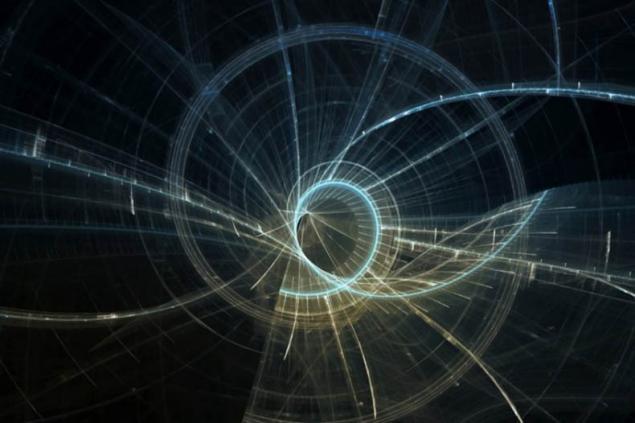
The idea of quantum computing, storing bits in individual atoms was proposed in the early 1980-ies Paul Benioff from Argonne national laboratory, located at the California Institute of technology, and David Deutsch of Oxford in England.
The first prototypes of quantum computers were not built until the early 1990-ies, when I figured out how to build the simplest version of such a computer. Dave Vinland, Nobel laureate in physics, won the Nobel prize including the formation of the first simple quantum computers. In 1994, however, there is a real incentive to produce them, when Peter Shor, then AT AT&T, and now he's at MIT showed that if it was possible to build a quantum computer, even a small one, with tens of thousands of quantum bits, he would be able to perform a million operations a piece of cake to its classic predecessor. If you make such a quantum computer to do the calculation of this Symphony, he could decipher all codes that we use to secretly transmit information via the Internet. And, as you know, after this statement, a lot of people pricked up his ears — not only individuals, but also agencies that would like to know people's secrets and to keep your own, of course. These agencies and many people said, "Oh, it would be great to create a quantum computer."
Thus, in the first half of 1990-ies originated the whole field of quantum computing, and my colleagues and I began to build quantum computers, everything in the world — not all of course, but hundreds of people around the world have also begun to create them. Now we have quantum computers, which even if you can't divide big numbers and hack cheats, however can do some interesting things.
We use quantum computers here at MIT to explore the fundamental physical properties of matter, and even trying to program a quantum computer so that it helped us to see what was happening in the Universe in the first moments of its existence.
You can use quantum computers to study the strange effects that carry names such as "confusion" when the light particles know about each other much more than they are entitled according to classical laws. You can use quantum computation and quantum communication to transfer confidential information, where reliability is guaranteed by the laws of nature. Even if these reasons are not good enough to carry out quantum computation, there is a different motivation: it's very exciting. I was working on quantum computers for the last 15 or 20 years and had great fun exploring how nature works at the smallest and fundamental levels. published
P. S. And remember, only by changing their consumption — together we change the world! ©
Join us in Facebook , Vkontakte, Odnoklassniki
Source: postnauka.ru/video/54343
A quantum computer is a device that stores and processes information at the level of individual atoms and elementary particles. In quantum computing there are two aspects: the first quantum and the second computational. "Quantum mechanics" — it sounds a little weird, and quantum mechanics is really unusual from a scientific point of view. But in a sense, the quantum aspect is easier to understand.
Quantum mechanics is a physical theory that explains how things behave on the small and fundamental level. It is the branch of physics that studies how atoms, photons (light particles), electrons, elementary particles behave. If we're going to build a computer at the level of atoms and the scale of elementary particles, it will inevitably work according to the laws of quantum mechanics. And we see that the strangeness of quantum mechanics the fact that quantum mechanics is weird and counterintuitive, in fact, allows us to calculate a way that was not for a laptop or iPhone.
The second aspect of quantum computing are the computing. So, what is a computer? Actually, it's kind of a difficult question, so I can say that computer is the computer where I see it when I type on it, or make phone calls or use Google maps. But in fact, the concept of the computer goes beyond the simple question of whether you have Apple or PC, iPhone or Samsung. This concept of information processing. What's a computer?
The digital computer receives the information and breaks it into smallest possible pieces called bits. Bit is an elementary distinction between two possibilities: Yes and no, true and false, zero and one or, for that matter, to low or high voltage charged capacitor in the computer. So the bits are physically stored within a conventional computer: low voltage capacitor is zero, the high unit.
To perform calculations the computer, having the information broken into tiny pieces, manipulates them, makes them interact and modifies them according to very General rules. In fact, there is the concept of a universal digital computing, covering the most complex tasks that can solve classical computer systematically in terms of bits. Thus, a quantum computer is a computer that takes bits and working with them in a systematic way, but it works at the level of atoms, elementary particles, photons (light particles), electrons — where reign the laws of quantum mechanics.
Quantum mechanics is weird. Strange is a scientific term. Niels Bohr, one of the founders of quantum mechanics said:
"Anyone who says he understands quantum mechanics, and he / she is not dizzy, really do not understand it."
Generally speaking, Danish is even more impressive. But it's true: quantum mechanics is weird and counterintuitive. To experience this oddity, think about what is called wave-particle duality. I know that sounds convoluted — corpuscular-wave dualism. What does that mean? This means that what we think of as particles, such as atoms or electrons, has a wave associated with it. Similarly, what we think of as waves, such as light or sound, has an associated particle. All this happens at a very microscopic level. This means that when you store a bit of information on a quantum computer, say, to the position of the electron, the electron also has an associated wave.
In a classical computer bit is stored in the following way: if zero is a low voltage — a bunch of electrons "here"; the unit is high voltage — a bunch of electrons "out there." Now let's zoom out to the point when we receive a quantum bit, i.e., one electron. So, one electron in one place, the unit is one electron in the other. Well, imagine the electron is zero, you move it back it becomes a unit, you move it here — he becomes again zero. You have two electrons, you move them around, you change a few bits — no problems with storing and processing information at the level of individual electrons.
The problem is that the electron is a quantum mechanical object, and though it is a particle also has a wave associated with it. This wave is directly related to where the electron is. If the wave of the electron is entirely in any one place, then the electron is there, and it will be zero. If the electron wave full here, the electron is also here, and this is one.
But the funny thing in quantum mechanics that waves should not be just here or just there. You know, they should not only be in any one place. Waves are extended objects, and in some cases, they can simultaneously be both here and there.
What this means is that the electron as a wave, is both here and there? This means that one electron is in two places at once. Thus, the quantum bit, or qubit as it is sometimes called, has an amusing quality: it can be at once a zero and unit, because the electron in two places at once. It's just weird and is counterintuitive. No classic image, which is illustrated. For example, a soccer ball can't be here and there simultaneously, even if the confusion on the field can sometimes create that impression. So, because the electron can be simultaneously in two places, the quantum bit, or qubit, can be both zero or one. Thus, this key feature of quantum weirdness — the wave-particle duality, mysterious, illogical and difficult to conventional thinking, means that quantum bits can have values of zero and one simultaneously. This means that quantum computers available methods of calculation that are impossible on classical computers.
You can think of it this way: if the classical computation is a sequence of bits changes a few times back and forth, you can imagine it as a wave, one wave, like a long note ("aaaaaaaaa") or one song ("Ah-Ah-Ah-Ah-Ah-Ah"). Thus, each of classical computing is like a single wave consisting of a series of pure notes. In quantum computing, on the contrary, the waves of all the bits can have several meanings at once, so it's a Symphony. I can't sing a Symphony alone, but you can imagine it represent. And what happens if quantum computing is the fact that the waves corresponding to each of the calculations, are summarized in such a way that between them there is interference and harmony. Thanks to this the possibilities that open up in front of a quantum computer, much more than classical computer.
So let's think it has a bit inside the computer. If I have zero or one bit may be information. Zero and one — it sounds so prosaic. Suppose I ask my fiancée or my girlfriend: "will You marry me?" And she sends me bits of information, where zero is "no" and one "Yes." This is a very important bit for me, and maybe she responds to me via mail, that's probably not the best way to accept the offer hands and hearts. For quantum of wedlock, she can send a quantum superposition of zero and one — this means that she is ambivalent in the quantum-mechanical sense. So what happens when I actually look at her response? These quantum bits have the property that if you have bits zero and one, where zero is "no" and one "Yes" at the same time, I will have to see if there's an electron. No. Is there? Yes. And then half the time I get the answer "no", and half the time — Yes. So if a friend of mine gave me that answer, it would be, in fact, tantamount to tossing a coin to decide what to respond to my offer.
In the computer a bit can be just a bit of information as zero or one, but it can also be instructions. So, zero might mean "do it" and one being "do that." To walk away from the marriage metaphors that makes me uncomfortable, to get away from metaphors about marriage, let's switch to math. So zero can command the computer to add 2 + 2. And unit can tell the computer, "Put 3 + 1". In a normal computer a bit can be either zero ("put 2 + 2"), or unit ("put 3 + 1"). But in a quantum computer, because quantum bits can have values of zero and one simultaneously, if you send it as instructions to the quantum computer, a quantum computer will be done by adding 2 + 2 and adding 3 + 1 in parallel, in some funny quantum sense. Thus, these two different calculations that occur at the same time, similar to the singing of two choirs or of simultaneous game two violins in the Symphony.
In fact, quantum computation is due to the interference between these various parts is like when we hear two sounds wafting to us at the same time, we perceive not each of them separately, but both of these sound together, interfering with each other. This may seem like magic, as in the construction of quantum computers you use components of the atomic scale, get a very-very small fit, and you should follow them, because if you lose one, you'll never again see. And you may ask: "Why do we all do when we have a great classical computers?"

The idea of quantum computing, storing bits in individual atoms was proposed in the early 1980-ies Paul Benioff from Argonne national laboratory, located at the California Institute of technology, and David Deutsch of Oxford in England.
The first prototypes of quantum computers were not built until the early 1990-ies, when I figured out how to build the simplest version of such a computer. Dave Vinland, Nobel laureate in physics, won the Nobel prize including the formation of the first simple quantum computers. In 1994, however, there is a real incentive to produce them, when Peter Shor, then AT AT&T, and now he's at MIT showed that if it was possible to build a quantum computer, even a small one, with tens of thousands of quantum bits, he would be able to perform a million operations a piece of cake to its classic predecessor. If you make such a quantum computer to do the calculation of this Symphony, he could decipher all codes that we use to secretly transmit information via the Internet. And, as you know, after this statement, a lot of people pricked up his ears — not only individuals, but also agencies that would like to know people's secrets and to keep your own, of course. These agencies and many people said, "Oh, it would be great to create a quantum computer."
Thus, in the first half of 1990-ies originated the whole field of quantum computing, and my colleagues and I began to build quantum computers, everything in the world — not all of course, but hundreds of people around the world have also begun to create them. Now we have quantum computers, which even if you can't divide big numbers and hack cheats, however can do some interesting things.
We use quantum computers here at MIT to explore the fundamental physical properties of matter, and even trying to program a quantum computer so that it helped us to see what was happening in the Universe in the first moments of its existence.
You can use quantum computers to study the strange effects that carry names such as "confusion" when the light particles know about each other much more than they are entitled according to classical laws. You can use quantum computation and quantum communication to transfer confidential information, where reliability is guaranteed by the laws of nature. Even if these reasons are not good enough to carry out quantum computation, there is a different motivation: it's very exciting. I was working on quantum computers for the last 15 or 20 years and had great fun exploring how nature works at the smallest and fundamental levels. published
P. S. And remember, only by changing their consumption — together we change the world! ©
Join us in Facebook , Vkontakte, Odnoklassniki
Source: postnauka.ru/video/54343


